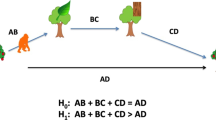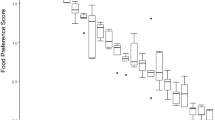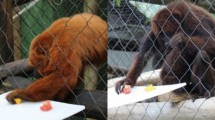Abstract
Ripe fruit eating shapes the behavior of most of the apes. Gorillas (Gorilla gorilla) and chimpanzees (Pan troglodytes) are very different sizes and, consequently, have been traditionally viewed as ecologically distinct, but few studies have explored the behavioral and physiological foundations of their diets. Debate continues on the extent that large-bodied gorillas may be less selective and more opportunistic fruit eaters than chimpanzees. Taste responses have been predicted to relate to body size and digestive strategies. This study employs laboratory research on taste perception and discrimination among captive zoo-housed chimpanzees and relates it to previous work on gorillas to better characterize diets and niche separation among these apes. During the captive trials, differences were recorded in consumption patterns of water and varying concentrations of dilute aqueous fructose (sweet) and tannic acid solutions (astringent), compounds commonly found in wild foods. The chimpanzees exhibited similar preference thresholds for fructose (50 mM) to other primates studied. They exhibited slightly lower inhibition thresholds for tannic acid solutions than gorillas, but higher than smaller primates studied to date. These preliminary findings suggest that tannin tolerance may well be mediated by body size, though possible species differences in salivary proteins or other sensory differences remain to be explored. This research furthers our efforts to understand the roles of body size and physiological adaptations in shaping diet and niche separation of chimpanzees and gorillas.




Similar content being viewed by others
References
Andrews P (1981) Species diversity and diet in monkeys and apes during the Miocene. In: Stringer CB (ed) Aspects of human evolution. Taylor and Francis, London, pp 25–61
Bartoshuk LM (1993) The biological basis of food perception and acceptance. Food Qual Prefer 4:21–32
Basabose AK (2002) Diet and composition of chimpanzees inhabiting the montane forest of Kahuzi, Democratic Republic of Congo. Am J Primatol 58:1–21
Benz JJ, Leger DW, French JA (1992) Relation between food preference and food elicited vocalizations in golden lion tamarins (Leontopithecus rosalia). J Comp Psychol 142–149
Bonnaire L, Simmen B (1994) Taste perception of fructose solutions and diet in lemuridae. Folia Primatol (Basel) 63:171–176
Caton JM (1999) A preliminary report on the digestive strategy of the western lowland gorilla. Aust Primatol 13:2–7
Chapman C, Wrangham RW, Chapman L (1995) Ecological constraints on group size: an analysis of spider monkey and chimpanzee subgroups. Behav Ecol Sociobiol 36:59–70
Chivers DJ, Hladik CM (1980) Morphology of the gastrointestinal tract in primates: comparisons with other mammals in relation to diet. J Morphol 166:337–386
Chivers DJ, Hladik CM (1984) Diet and gut morphology in primates. In: Chivers DJ, Wood BA, Bilsburough A (eds) Food acquisition and processing in primates. Plenum Press, New York, pp 213–230
Collet JY, Bourreau E, Cooper RW, Tutin CEG, Fernandez M (1984) Experimental demonstration of cellulose digestion by Troglodytella gorillae, an intestinal ciliate of lowland gorillas. Int J Primatol 5:328
Demment ME, van Soest PJ (1985) A nutritional explanation of body-size patterns of ruminant and non-ruminant herbivores. Am Nat 125: 641–672
Doran DM, McNeilage A, Greer D, Bocian C, Mehlman P, Shah N (2002) Western lowland gorilla diet and resource availability: New evidence, cross-site comparisons, and reflections on indirect sampling methods. Am J Primatol 58:91–116
Feeney PP (1976) Plant apparency and chemical defense. Recent Adv Phytochem 10:1–40
Fickel J, Joest BA (1997) Roe deer (Capreolus capreolus): properties of parotid and mixed saliva. In: Second conference of the nutrition advisory group, Ft. Worth, TX, American Zoo and Aquarium Association on Zoo and Wildlife Nutrition. NAG/AZA
File SK, McGrew WC, Tutin CEG (1976) The intestinal parasites of a community of feral chimpanzees, Pan troglodytes schweinfurthii. J Parasitol 62:259–261
Freeland WJ, Janzen DH (1974) Strategies in herbivory by mammals: the role of plant secondary compounds. Am Nat 108:269–289
Ganzhorn JU (1989) Primate species separation in relation to secondary plant chemicals. Hum Evol 4:125–132
Glaser D, Hobi G (1985) Taste responses in primates to citric and acetic acid. Int J Primatol 6:395–398
Glaser D, Hellekant G, Brouwer JN, van der Wel H (1978) The taste responses in primates to the proteins thaurnatin and monellin and their phylogenetic implications. Folia Primatol (Basel) 29:56–63
Goldsmith ML (2003) Comparative behavioral ecology of a lowland and highland gorilla population: where do Bwindi gorillas fit?. In: Taylor A, Goldsmith ML, Gorilla (eds) Gorilla biology: a multidisciplinary perspective. Cambridge University Press, Cambridge, pp 358–84
Hellekant G, Hard AF, Segerstad C, Roberts R, van der Wel H, et al (1985) Effects of gymnemic acid on the chorda tympani proper nerve responses to sweet, sour, salty and bitter taste stimuli in chimpanzee. Acta Phys Scand 124:339–408
Hladik CM (1977) Chimpanzees of gabon and chimpanzees of gombe: some comparative data on diet. In: Clutton-Brock TH (ed) Primate ecology. Academic Press, New York, pp 481–501
Hladik CM (1979) Diet and ecology of prosimians. In: Doyle GA, Martin RD (eds) The study of prosimian behavior. Academic Press, London pp 307–357
Hladik CM, Hladik A, Bousset J, Valdebouze P, Viroben G, Delort-Laval J (1971) Le régime alimentaire des Primates de I’île de Barro-Calorado, Panama. Folia Primatol (Basel)16:85–122
Hladik CM, Simmen B (1996) Taste perception and feeding behavior in nonhuman primates and human populations. Evol Anthropol 5:58–71
Jungers WL, Susman RL (1984) Body size and skeletal allometry in African apes. In: Susman RL (ed) The pygmy chimpanzee. Evolutionary biology and behavior. Plenum, New York, pp 131–178
Kay RF (1975) The functional adaptations of primate molar teeth. Am J Phys Anthropol 43:195–216
Kuroda S, Nishihara T, Suzuki S, Oko RA (1996) Sympatric chimpanzees and gorillas in the Ndoki Forest, Congo. In: MdGres WC, Marchant LF, Nishida T (eds) Great ape societies. Cambridge University Press, Cambridge, pp 71–81
Laska M (1994) Taste difference thresholds for sucrose in squirrel monkeys (Saimiri sciureus). Folia Primatol (Basel) 63:144–148
Laska M (1999) Taste responsiveness to food-associated acids in the squirrel monkey (Saimiri sciureus). J Chem Ecol 25:1623–1632
Laska M, Scheuber HP, Carrera Sanchez E, Rodriguez LE (1999b) Taste difference thresholds for sucrose in two species of nonhuman primates. Am J Primatol 48:153–160
Laska ME, Schuell, Scheuber HP (1999a) Taste preference thresholds for food-associated sugars in baboons (Papio hamadryas anubis). Int J Primatol 20:25–34
Lyman B, Green B (1990) Oral astringency: effects of repeated exposure and interactions with sweeteners. Chem Senses 15:151–164
Martin RD, Chivers DJ, Maclarnon AM, Hladik CM (1985) Gastrointestinal allometry in primates and other mammals. In: Jungers WL (ed) Size and scaling in nonhuman primates. Plenum Press, New York, pp 61–89
Mehansho H, Butlerb LG et al. (1987) “Dietary tannins and salivary prpoline-rich proteins: interactions, induction and defense mechanisms”. Annu Rev Nutr 7:423–440
Milton K, Demment MW (1988) Digestion and passage kinetics of chimpanzees fed high and low fiber diets and comparison with human data. J Nutr 1082–1088
Mole S, Waterman PG (1987) Tannins as antifeedants to mammalian herbivores–still an open question?. In: Waller GR (ed) Allelochemicals: role in agriculture and forestry. American Chemical Society Press, Washington DC, pp 572–587
Nishida T (1976) The bark-eating habits in primates, with special reference to their status in the diet of wild chimpanzees. Folia Primatol (Basel) 25:277–287
Nishida T, Uehara S (1983) Natural diet of chimpanzees: long term record from the Mahale Mountains, Tanzania. Afr Study Monogr 3:109–130
Nishida T, Ohigashi H, Koshimizu K (2000) Tastes of chimpanzee plant foods. Curr Anthropol 41:431–438
Parra R (1978) Comparison of foregut and hindgut fermentation in herbivores. In: Montgomery GG (ed) The ecology of arboreal folivores. Smithsonian Press, Washington DC, pp 205–229
Plumptre AJ (1995) The chemical composition of montane plants and its influence on the diet of large mammalian herbivores in the Parc National des Volcans, Rwanda. J Zool 235:323–337
Popovich DG, Jenkins DJA, Kendall CWC, Dierenfeld ES, Carroll RW, et al. (1997) The western lowland gorilla diet has implications for the health of humans and other hominoids. J Nutr 127:2000–2005
Remis M, Dierenfeld ES (2004) Digesta passage, digestibility and behavior in captive gorillas under two dietary regimens. Int J Primatol 25:825–846
Remis MJ (1997a) Western lowland gorillas as seasonal frugivores: use of variable resources. Am J Primatol 43:87–109
Remis MJ (1997b) Ranging and grouping patterns of a western lowland gorilla group at Bai Hokou, Central African Republic. Am J Primatol 43:111–133
Remis MJ (2002) Food preferences among captive western lowland gorillas (Gorilla gorilla gorilla) and chimpanzees (Pan troglodytes spp): relationship to feeding strategies. Int J Primatol 23:231–249
Remis MJ (2003) Are gorillas vacuum cleaners of the forest floor? The roles of body size, habitat and food preferences on dietary flexibility and nutrition. In: Taylor AB, Goldsmith ML (eds) Gorilla biology: a multidisciplinary perspective. Cambridge University Press, Cambridge, pp 385–404
Remis MJ, Dierenfeld ES, Mowry CB, Carroll RW (2001) Nutritional aspects of western lowland gorilla (Gorilla gorilla gorilla) diet during seasons of fruit scarcity at Bai Hokou, Central African Republic. Int J Primatol 22:807–836
Remis MJ, Kerr MJ (2002) Taste responses to fructose and tannic acid among gorillas (Gorilla gorilla gorilla). Int J Primatol 23:251–261
Reynolds V, Plumptre AJ, Greenham J (1998) Condensed tannins and sugars in the diet of chimpanzees (Pan troglodytes schweinfurthii) in the Budongo Forest, Uganda. Oecologia 115:331–336
Rhodes DF, Cates RG (1976) Toward a general theory of plant antiherbivore chemistry. In: Wallace JW, Mansell RL (eds) Biochemical interaction between plants and insects. Plenum, New York, pp 168–213
Rogers ME, Abernethy K, Bermejo M, Cipolletta C, Doran D et al (2004) Western gorilla diet: a synthesis from six sites. Am J Primatol 64:173–192
Rogers ME, Williamson E, Tutin C, Fernandez M (1990) Gorilla diet in the Lope Reserve, Gabon: a nutritional analysis. Oecologia 84:326–339
Rozin P, Vollmecke TA (1986) Food likes and dislikes. Annu Rev Nutr 6:433–456
Rozin PK, Kennel K (1983) Acquired preferences for piquant foods by chimpanzees. Appetite J Intake Res 4:69–77
Salier LD, Gaulin JC, Boster JS, Kurland JA (1985) Measuring the relationship between dietary quality and body size in primates. Primates 26:14–27
Shea BT (1983a) Size and diet in the evolution of African ape craniodental form. Folia Primatol (Basel) 40:32–68
Simmen B (1994) Taste discrimination and diet differentiation among New World primates. In: Chivers DJ, Langer P (eds) The digestive system in mammals: food, form and function. Cambridge University Press, Cambridge, pp 150–164
Simmen B, Hladik CM (1988) Seasonal variation of taste threshold for sucrose in a prosimian species, Microcebus murinus. Folia Primatol (Basel) 51:152–157
Simmen B, Hladik CM (1998) Sweet and bitter taste discrimination in primates: scaling effects across species. Folia Primatol (Basel) 69:129–138
Simmen B, Josseaume B, Atramentowicz M (1999) Frugivory and taste responses to fructose and tannic acid in a prosimian primate and a didelphid marsupial. J Chem Ecol 25:331–346
Simmen B, Charlot S (2003) A comparison of taste thresholds for sweet and astringent-tasting compounds in great apes. Compt Rend Biol 326:449–455
Stanford CB, Bosco N, Kurunungi J (2003) Behavioral ecology of sympatric chimpanzees and gorillas in Bwindi Impenetrable National Park, Uganda: diet. Int J Primatol 24:901–918
Steiner JE, Glaser D (1984) Differential behavioral responses to taste stimuli in non-human primates. J Hum Evol 13:709–723
Steiner JE, Reuveni J, Beja Y (1982) Simultaneous multidisciplinary measures of taste hedonics. In: Steiner JE, Ganchrow JR (eds) Determination of behavior by chemical stimuli. IRL Press, London, pp 149–160
Sugiyama Y, Koman J (1987) A preliminary list of chimpanzees’ alimentation at Bossou, Guinea. Primates 28:133–147
Temerin A, Wheatley B, Rodman PS (1984) Body size and foraging in primates. In: Rodman PS, Cant J (eds) Adaptations for foraging in nonhuman primates: contributions to an organismal biology of prosimians, monkeys and apes. Columbia University Press, New York, pp 217–248
Temerin AL, Cant JGH (1983) The evolutionary divergence of old world monkeys and apes. Am Nat 122:335–351
Tutin C (1996) Ranging and social structure of lowland gorillas in the Lope Reserve, Gabon. In: McGrew WC, Marchant L, Nishida T (eds) Great ape societies. Cambridge University Press, Cambridge, pp 58–70
Tutin CEG, Fernandez M (1993) Composition of the diet of chimpanzees and comparisons with that of sympatric lowland gorillas in the Lope Reserve, Gabon. Am J Primatol 30:195–211
Tutin CEG, Fernandez M, Rogers ME, Williamson EA, McGrew WC (1991) Foraging profiles of sympatric lowland gorillas and chimpanzees in the Lope Reserve, Gabon. Philos Trans R Soc Lond B 334:179–186
Waterman PG, Choo GM, Vedder AL, Watts DP (1983) Digestibility, digestion-inhibitors, and nutrients of herbaceous foliage and green stems from an African montane flora and comparison with other tropical flora. Oecologia 60:244–249
Waterman PG, Mole S (1994) Analysis of phenolic plant metabolites. Blackwell, Oxford
Wene JD, Barnwell GM, Mitchell DS (1982) Flavor preferences, food intake, and weight gain in baboons (Papio spp.). Physiol Behav 28:569–573
Wrangham RW (1977) Feeding behavior of chimpanzees in Gombe National Park, Tanzania. In: Clutton-Brock TH (ed) Feeding ecology: studies of feeding and ranging behavior in lemurs, monkeys and apes. Academic Press, London, pp 504–538
Wrangham RW (1979a) Sex differnces in chimpanzee dispersion. In: Hamburg DA, McCown ER (eds) The great apes. Benjamin/Cummings, Menlo Park, pp 481–490
Wrangham RW, Conklin-Brittain NL, Hunt KD (1998) Dietary response of chimpanzees and cercopithecines to seasonal variation in fruit abundance 1 antifeedants. Int J Primatol 19:949–970
Wrangham RW, Waterman PG (1983) Condensed tannins in fruits eaten by chimpanzees. Biotropica 15:217–222
Yamagiwa J (2004) Diet and foraging of the great apes: ecological constraints on their social organizations and implications for their divergence. In: Russon AE, Begun DR (eds) The evolution of thought: evolutionary origins of great ape intelligence. Cambridge University Press, Cambridge, pp 210–233
Yamagiwa J, Maruhashi T, Yumoto T, Mwanza N (1996) Dietary and ranging overlap in sympatric gorillas and chimpanzees in Kahuzi-Biega National Park, Zaire. In: McGrew WC, Marchant LF, Nishida T (eds) Great ape societies. Cambridge University Press, Cambridge, pp 82–98
Zihlman AL (1997) Natural history of apes: life-history features of females and males. In: Morbeck ME, Galloway A, Zihlman AL (eds) The evolving female: a life-history perspective. Princeton University Press, Princeton, pp 185–197
Acknowledgements
I would like to thank Professor J. Yamagiwa for the invitation to participate in the African great apes: evolution, diversity and conservation conference and Professor T. Nishida for inspiring us all in our efforts to understand ape diet and behavior. This research was conducted under the guidance of the Purdue Animal Care and use Committee (97–099). The research complies with the ethical standards in the treatment of animals with the guidelines laid down by the NIH (US). It was supported by a National Science Foundation Grant (BCS-9815841) and funds from Purdue University. The San Francisco Zoo granted permission for the captive research. Lisa Hamburg, Mary Kerr and other dedicated Zoo staff facilitated and collaborated on this effort and the comments of three reviewers enhanced the final product.
Author information
Authors and Affiliations
Corresponding author
About this article
Cite this article
Remis, M.J. The role of taste in food selection by African apes: implications for niche separation and overlap in tropical forests. Primates 47, 56–64 (2006). https://doi.org/10.1007/s10329-005-0145-9
Received:
Accepted:
Published:
Issue Date:
DOI: https://doi.org/10.1007/s10329-005-0145-9




